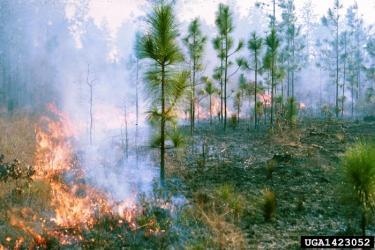Understanding your woodland’s fire regime
There are many factors that impact your forest’s fire regime, but you can break down your fire regime into two main factors: frequency and severity.
- Fire frequency describes how often fire burns on a particular piece of ground. Importantly, frequency is measured by how often fire burned historically, before widespread fire suppression.
- Fire severity describes the effect of the typical fire on vegetation–specifically how much of the vegetation did an average fire kill historically?
Using these two variables, the U.S. Forest Service has come up with five “Fire Regime Groups” that describe the main fire regimes in the United States. The groups are defined by differing combinations of frequency and severity–from landscapes that experience frequent, low-intensity fires, to landscapes that experience rare but intense fires.
- Fire Regime 1: Fire burns harmlessly and often through the understory of a forest whose trees generally survive the fire.
- Fire Regime 2: Occurs where there are no trees and all of the vegetation is consumed, as in grassland fire.
- Fire Regime 3: Occurs where fire is a dominant force but is somewhat less frequent than regimes 1 and 2. In this regime, some patches of vegetation are completely killed, while others barely burn.
- Fire Regime 4: Fire is still fairly frequent but is less patchy than in Fire Regime 3. Fires in regime 4 will kill most of the aboveground vegetation but regrowth is often possible.
- Fire Regime 5: Occurs where fire is very uncommon and vegetation develops complex “old-growth” structure between fires that consume everything.
Different fire regimes are generally the result of climate and topography, which control both the kind of vegetation that can grow in a particular location and the likelihood of fire. Fire Regime 5, for example, tends to occur where the climate is cool and wet, so fire comes infrequently but can be intense due to the lush vegetation typical of this climate. Fire Regime 1 occurs where the climate supports trees but seasonal dry spells ensure that “fire weather” is common.
How can I get more tips?
It’s simple! Enter your email below.

